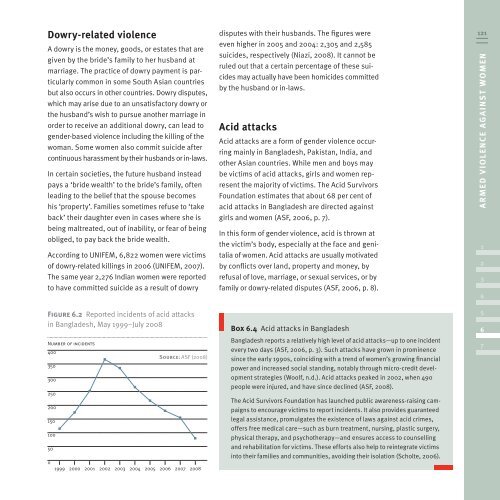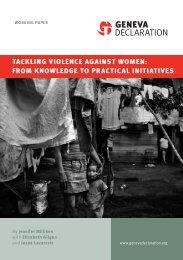Global Burden of Armed Violence - The Geneva Declaration on ...
Global Burden of Armed Violence - The Geneva Declaration on ...
Global Burden of Armed Violence - The Geneva Declaration on ...
Create successful ePaper yourself
Turn your PDF publications into a flip-book with our unique Google optimized e-Paper software.
Dowry-related violence<br />
A dowry is the m<strong>on</strong>ey, goods, or estates that are<br />
given by the bride’s family to her husband at<br />
marriage. <str<strong>on</strong>g>The</str<strong>on</strong>g> practice <str<strong>on</strong>g>of</str<strong>on</strong>g> dowry payment is particularly<br />
comm<strong>on</strong> in some South Asian countries<br />
but also occurs in other countries. Dowry disputes,<br />
which may arise due to an unsatisfactory dowry or<br />
the husband’s wish to pursue another marriage in<br />
order to receive an additi<strong>on</strong>al dowry, can lead to<br />
gender-based violence including the killing <str<strong>on</strong>g>of</str<strong>on</strong>g> the<br />
woman. Some women also commit suicide after<br />
c<strong>on</strong>tinuous harassment by their husbands or in-laws.<br />
In certain societies, the future husband instead<br />
pays a ‘bride wealth’ to the bride’s family, <str<strong>on</strong>g>of</str<strong>on</strong>g>ten<br />
leading to the belief that the spouse becomes<br />
his ‘property’. Families sometimes refuse to ‘take<br />
back’ their daughter even in cases where she is<br />
being maltreated, out <str<strong>on</strong>g>of</str<strong>on</strong>g> inability, or fear <str<strong>on</strong>g>of</str<strong>on</strong>g> being<br />
obliged, to pay back the bride wealth.<br />
According to UNIFEM, 6,822 women were victims<br />
<str<strong>on</strong>g>of</str<strong>on</strong>g> dowry-related killings in 2006 (UNIFEM, 2007).<br />
<str<strong>on</strong>g>The</str<strong>on</strong>g> same year 2,276 Indian women were reported<br />
to have committed suicide as a result <str<strong>on</strong>g>of</str<strong>on</strong>g> dowry<br />
Figure 6.2 Reported incidents <str<strong>on</strong>g>of</str<strong>on</strong>g> acid attacks<br />
in Bangladesh, May 1999–July 2008<br />
Number <str<strong>on</strong>g>of</str<strong>on</strong>g> incidents<br />
400<br />
350<br />
300<br />
250<br />
200<br />
150<br />
100<br />
50<br />
0<br />
Source: ASF (2008)<br />
1999 2000 2001 2002 2003 2004 2005 2006 2007 2008<br />
disputes with their husbands. <str<strong>on</strong>g>The</str<strong>on</strong>g> figures were<br />
even higher in 2005 and 2004: 2,305 and 2,585<br />
suicides, respectively (Niazi, 2008). It cannot be<br />
ruled out that a certain percentage <str<strong>on</strong>g>of</str<strong>on</strong>g> these suicides<br />
may actually have been homicides committed<br />
by the husband or in-laws.<br />
Acid attacks<br />
Acid attacks are a form <str<strong>on</strong>g>of</str<strong>on</strong>g> gender violence occurring<br />
mainly in Bangladesh, Pakistan, India, and<br />
other Asian countries. While men and boys may<br />
be victims <str<strong>on</strong>g>of</str<strong>on</strong>g> acid attacks, girls and women represent<br />
the majority <str<strong>on</strong>g>of</str<strong>on</strong>g> victims. <str<strong>on</strong>g>The</str<strong>on</strong>g> Acid Survivors<br />
Foundati<strong>on</strong> estimates that about 68 per cent <str<strong>on</strong>g>of</str<strong>on</strong>g><br />
acid attacks in Bangladesh are directed against<br />
girls and women (ASF, 2006, p. 7).<br />
In this form <str<strong>on</strong>g>of</str<strong>on</strong>g> gender violence, acid is thrown at<br />
the victim’s body, especially at the face and genitalia<br />
<str<strong>on</strong>g>of</str<strong>on</strong>g> women. Acid attacks are usually motivated<br />
by c<strong>on</strong>flicts over land, property and m<strong>on</strong>ey, by<br />
refusal <str<strong>on</strong>g>of</str<strong>on</strong>g> love, marriage, or sexual services, or by<br />
family or dowry-related disputes (ASF, 2006, p. 8).<br />
Box 6.4 Acid attacks in Bangladesh<br />
Bangladesh reports a relatively high level <str<strong>on</strong>g>of</str<strong>on</strong>g> acid attacks—up to <strong>on</strong>e incident<br />
every two days (ASF, 2006, p. 3). Such attacks have grown in prominence<br />
since the early 1990s, coinciding with a trend <str<strong>on</strong>g>of</str<strong>on</strong>g> women’s growing financial<br />
power and increased social standing, notably through micro-credit development<br />
strategies (Woolf, n.d.). Acid attacks peaked in 2002, when 490<br />
people were injured, and have since declined (ASF, 2008).<br />
<str<strong>on</strong>g>The</str<strong>on</strong>g> Acid Survivors Foundati<strong>on</strong> has launched public awareness-raising campaigns<br />
to encourage victims to report incidents. It also provides guaranteed<br />
legal assistance, promulgates the existence <str<strong>on</strong>g>of</str<strong>on</strong>g> laws against acid crimes,<br />
<str<strong>on</strong>g>of</str<strong>on</strong>g>fers free medical care—such as burn treatment, nursing, plastic surgery,<br />
physical therapy, and psychotherapy—and ensures access to counselling<br />
and rehabilitati<strong>on</strong> for victims. <str<strong>on</strong>g>The</str<strong>on</strong>g>se efforts also help to reintegrate victims<br />
into their families and communities, avoiding their isolati<strong>on</strong> (Scholte, 2006).<br />
121<br />
A R M E D V I O L E N C E AG A I N S T WOMEN<br />
1<br />
2<br />
3<br />
4<br />
5<br />
6<br />
7









